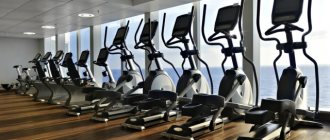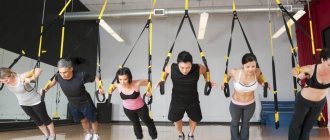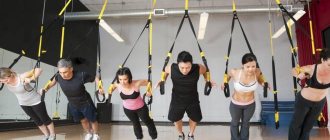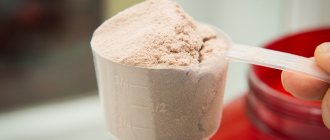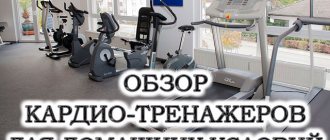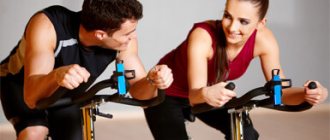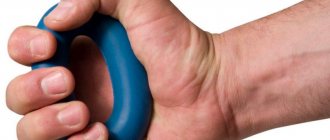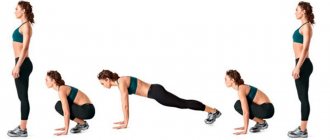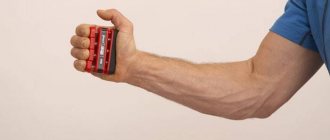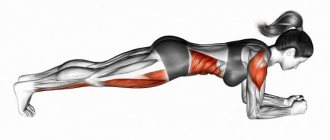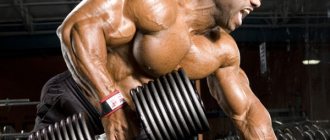A sense of balance and poise is important for every person, especially athletes. There are many different ways to develop these qualities, for example, using a balance board. There are several different types on the market, so it is important to know how to choose the best model.
What is a balance board?
Balance board is a set that allows you to develop balance and put stress on the whole body. It includes a board that is mounted on a roller to balance the board; it is also called a roller. A person stands on this structure and tries to maintain balance by rolling from one side to the other. The most common version has a board length of up to 80 cm and a cylinder diameter of up to 17 cm.
Benefits of classes
In addition to having fun, the exercise machine brings maximum benefits to the body:
- develops balance, coordination and vestibular apparatus;
- trains the calf muscles;
- regular exercises reduce back and lower back pain by improving blood circulation;
- promotes weight loss.
The balance board is suitable for all people, regardless of their sports affiliation. It is especially popular among office workers who are forced to spend a lot of time in a sitting position.
Why do you need a balance board?
In addition to its main purpose, the design also performs other functions:
- Exercises on such a board provide an excellent load on the muscles, even those that are not used during regular exercises.
- The benefit of a balance board is the ability to get rid of stoop and get beautiful posture.
- Training on this structure will be useful for those who want to learn how to ride a snowboard, skateboard and other equipment where they need to maintain balance.
- Describing a balance board - what it is and what its benefits are, we note that training on it gives the correct load on the ankle joint. This is especially important for people who engage in extreme sports.
- Board balance training is recommended during post-traumatic rehabilitation, as it helps strengthen the spine, develop the vestibular system, and so on.
Anatomical map of the complexes
Let us consider the main exercises presented in order to describe their capabilities for developing the functional strength of an athlete.
| Exercise | Type | Efficiency of board balance | Target muscle group | Danger when performing |
| Front squats | Basic | High | Gluteal muscles + core stabilizer muscles | Average |
| Longitudinal squats | Basic | Average | Working out the quadriceps and lateral abdominal muscles | Average |
| Crunches | Insulating | Low | Abdominal muscles and core | Absent |
| Thrusters | Complex | High | Upper shoulder girdle | High |
| Medicine Ball Throws | Aerobic | High | Upper shoulder girdle | Moderate |
| Plank | Complex | High | Abdominal muscles and core | Absent |
| Dumbbell lateral raises | Insulating | Low | Upper deltas | High |
| Front dumbbell raises | Insulating | Low | Front delts | High |
| Tilt wiring | Insulating | Low | Rear delts | Very high |
| Barbell row to the chin | Insulating | Low | trapezoids | Moderate |
| Lunges | Basic | High | Gluteal muscles + core stabilizer muscles | Absent |
| Push ups | Basic | High | Abdominal muscles and core | Absent |
| Bent-over weight row | Basic | Low | Back muscles (latissimus + rhomboid + trapezius) | Extremely high |
As can be seen from the table data, despite the high efficiency of the balance board when performing some exercises, combining it with lifting heavy weights is ineffective and very dangerous. The best development is provided by exercises that require removing the body from balance and maximum amplitude (squats, push-ups).
Balance board – pros and cons
Like any other equipment, this one also has its advantages and disadvantages. A balance board is a sports set that has the following advantages:
- develops the whole body;
- simplicity of design;
- low price of simple options;
- opportunity to do it yourself.
The balance of the board is not without its drawbacks, which include:
- the projectile is hazardous;
- training will not help increase muscle volume;
- low-quality models can quickly break.
Types of balance boards
There are different types of products on the market:
- Rocker boards
. This balance board is made of plastic or wood. The platform is connected to the support, creating a one-piece structure. You can move on it both to the sides and forward/backward. This is the simplest design, ideal for beginners. - Wobble Boards
. The hemispherical board has a central fulcrum, which ensures 360° movement. Often such options are used to complicate training, for example, they perform squats. The support is removable, which helps to change the height of the structure. - Rocker Roller Boards
. The set consists of a separate board, which is similar in shape to a skateboard. The roller is in the shape of a cylinder or cone, which complicates the load due to its instability. - Sphere and Ring Boards
. The board for such sets is separate, and it can be spherical or ring-shaped. It rests on a rubber ball. This option is used by experienced athletes. - Spring Boards
. The design consists of two platforms, and between them there are springs that provide instability. This machine can be used to make strength exercises more challenging.
Balance board form
The boards in this design can have different shapes, which affects the difficulty of maintaining balance.
- Original
. A simple and popular option with an oval shape. A round balance board is also common and is often used during fitness training. - Diamond and Short
. Very similar boards that have the same shape at the top, but differ in the tails. In the first option, it looks like a diamond, which is reflected in the name. - Legendary
. This is a universal board that looks like a surfboard. This option is considered optimal for beginners and professionals. - Hawaii
. A comfortable board that is ideal for performing slow exercises, because it is easy to maintain balance on it. - YogaBoard
. This board is the largest and most reliable. It is often used for yoga and Pilates classes. This is a suitable balance board for children.
Lunges
Despite its name, this exercise cannot be called lunges in its classical sense. The correct name is a front leg squat. From the point of view of the effectiveness of muscle development and coordination, its effectiveness is maximum. The technique is quite simple:
- The feet are placed on the edges of the board lengthwise, not across.
- Balance is maintained with the entire body, without focusing on the hip joint or heel pressure.
- You need to squat so that the knee of the non-supporting leg is as close to the board as possible.
How to choose a balance board?
When choosing a suitable set, you need to focus on your skills and physical fitness. Do not forget about the wide range of products, among which there are certainly fakes. Recommendations on how to choose a balance board for a beginner:
- Look for decks made of durable plastic or wood. In the second case, it must be well polished, free from defects and covered with several layers of varnish.
- The presence of stoppers on the sides is of great importance, which is important for safety and the absence of slipping.
- As for the rollers, inexpensive options look like a regular pipe, while more expensive ones are already covered with rubber. Professional models are presented with a cast PVC roller.
- Look at the maximum load the deck can support.
- If you focus on the design of the board, then it all depends on personal preferences.
Balance board dimensions
The optimal diameter of the cylinder is 16 cm, which helps even beginners maintain balance. The shorter its length, the more difficult it will be to practice. As for the length of the balance board for balance training, it is selected depending on the person’s height. Universal options have a length of 75 cm, which gives you a chance to stand on it comfortably. Tall people should choose longer boards. As for the width of the deck, the optimal size is 35 cm.
TOP board balance
When choosing, it is recommended to pay attention to the rating of the best manufacturers of such structures. Traditionally, the TOP of the best boards includes sets of these brands:
- TREEKIX
. The manufacturer uses high-quality materials for products: wood and polymers. The designs are thought out to the smallest detail, creating the best balance boards for customers. - IndSpace
. This brand produces wooden decks and plastic supports. The balance board trainer can withstand up to 150 kg. The manufacturer offers an elastic mat as a bonus. - XBOARD
. The board of this brand can withstand loads of up to 200 kg. The manufacturer equips it with removable limiters. You can purchase a roller with a diameter of 11-16 cm.
DIY balance board
In order not to spend money and if you know how to handle tools, you can build a simulator with your own hands. To work you need to prepare:
- cardboard (minimum 8 mm thick) or water pipe;
- plywood 20-40 mm thick;
- plywood for limiters;
- sandpaper;
- wood glue, coating varnish;
- nails or screws.
When everything is prepared, follow the simple instructions on how to make a balance board:
- If the roller is made of cardboard, then open it with acrylic waterproof varnish to increase durability. Leave to dry for 2-4 hours.
- Cut out the deck blank and sand it. The edges should be rounded.
- To install the stops, measure 16 mm from the edges and attach the plywood with a screwdriver. Do this on both sides. Round the edges and go over them with sandpaper. Cover both sides with varnish.
How to practice on a balance board?
It is important to take care of free space before starting training. Nothing should get in the way to avoid injury if you fall. Balance board exercises should not take place on the day of the main training, since the load on the stabilizer muscles reduces the effectiveness of performing basic exercises, and the risk of injury also increases.
How to balance the board?
Beginners need support when trying to get on the board for the first time. This can be either a person or special holders for the wall, which should be at chest level. The structure is installed on a non-slip mat, which should be 3-5 times larger than the simulator. Balance board training includes the following:
- Resting against the wall, stand on the board with your feet on opposite sides.
- There is no need to strain your body too much, as this will make it difficult to maintain balance.
- Moving your body to the left or to the right, you need to balance the roller so that it is located in the center of the board.
- According to the advice of professionals, it is important to remain in this position for at least 15 minutes so that the body gets used to it.
About the disadvantages
A balance board has many advantages: it develops large muscle groups and small stabilizers, and helps to practice the technique of complex techniques. But there are also disadvantages. To achieve a noticeable transformation of the body, serious training in a complex program will be required. Only a person in good physical shape can cope with this.
Disadvantages will also be noticed by those who play sports with the goal of increasing the amount of muscle mass. The position of the body on the board is very unstable, using heavy weights is dangerous, it can lead to injury. At the same time, small weights do not allow achieving the necessary metabolic response from the muscular system. In this case, the efficiency will be low.
There is a risk of injury even without using weights. To protect yourself, you should work with the correct technique and be extremely attentive to every movement. Children's activities must be supervised by adults. Use for other purposes is strictly prohibited, as this can lead to sprains and ruptures of muscle tissue and tendons.
Board balance exercises
There are a huge number of exercises that athletes perform. There are balance board tricks for both beginners and professionals.
- Balance while sitting
. You can perform the exercises not only standing, but also sitting. Position yourself on the board with your legs extended forward and your hands behind your back, holding the board. You need to maintain balance, and your feet should not touch the floor. - Balance on the roller
. You can only do tricks on a roller. You need to stand across it and find balance. To complicate this exercise, you can learn how to roll on a roller. - Balance on each leg
. Stand on the board with one foot in front and the other behind. Keep your balance, and you can add rolls to make it more difficult. - Knee squat
. Standing as in the previous exercise, that is, one leg behind, the other in front. Maintaining your balance, slowly lower your back knee onto the board and rise up smoothly. Switch legs and perform on the other side.
For the abdominals
This is a very large and strong group. To provide them with sufficient stress, certain actions are necessary.
Rifles
You need to stand and press your heels, then slowly move your body weight to one side by moving the area just above the pelvis. The load on the legs will be redistributed, but the stability of the body should remain unchanged. After a roll in one direction, movement in the other immediately begins. The same can be done in a longitudinal stance, but the abdominal lumbar ligament will be responsible for stability, and to perform a roll, the foot is shifted from heel to toe.
Thrusters
While very difficult in themselves, the instability makes the task even more difficult. The ability to perform them indicates excellent coordination. You can use a trap bar or dumbbells, but no more than 10% of your rep max. It is prohibited to use a classic bar, as this will lead to an undesirable shift in the center of gravity.
First, stand on the surface, leaning on your heels like a balance beam. The feet are placed so that when bending the knees look to the sides, this is an important condition for their safety, and this way the position will be more stable. The action will not be divided into phases, as with a classic pushing movement. All phases take place in one movement, the push-off at the shoulder joint is done parallel to the exit from the squat.
Plank
When performed without stable support, tension in the oblique abdominal muscles increases, and punk becomes more effective. You need to take an emphasis while lying down, placing your forearms on the surface of the simulator. It is important to balance using the torso, and not solely the shoulder joint, and it should not rotate. To complicate the task, you can add rolls to the bar, but the body must remain parallel to the floor.
